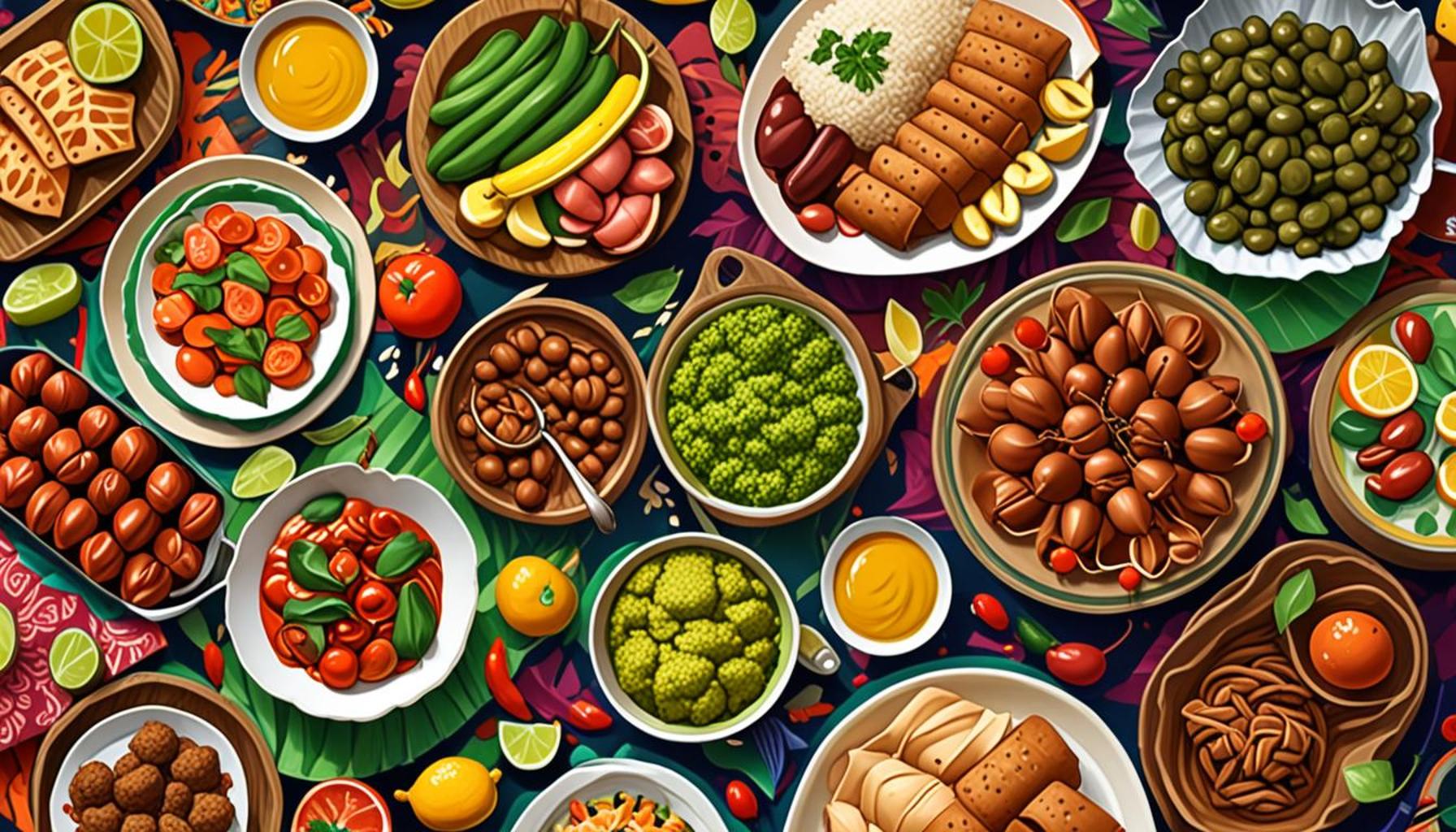Flavors of Nigeria: A Culinary Itinerary through the North and South

A Journey Through Nigeria’s Culinary Landscape
Nigeria’s culinary diversity is as vibrant and multifaceted as its people, reflecting a history enriched by various cultural influences yet firmly rooted in tradition. Each region boasts its own unique ingredients, flavors, and cooking techniques, making Nigerian food an intricate tapestry of tastes and stories that have been passed down through generations.
This culinary itinerary takes you on a flavorful journey through:
- Northern Delights: The North is renowned for its spicy stews, often made with rich, flavorful meats and legumes. Dishes like Jollof rice, a beloved party staple, are seasoned with a myriad of spices, while Suya, skewered and spiced meat, tantalizes with its smoky flavor. Northern Nigerian cuisine heavily features unique grains such as millet and sorghum, which serve as the base for various meals, highlighting the region’s agricultural profile.
- Southern Selections: In sharp contrast, the South is a cornucopia of seafood and palm oil-based delicacies. Dishes such as Egusi soup, made with ground melon seeds and laden with vegetables, stand out for their rich texture and potent flavors. The coastal areas of Lagos boast an abundance of fresh fish, leading to mouthwatering preparations that include crabs, prawns, and various types of shellfish.
The variance in offerings from one Nigerian state to another is profound and intriguing, deeply influenced by local geography, climate, and cultural practices. For example, while Lagos thrives with its vibrant urban markets, showcasing street food like Puff-Puff and Akara, Kano’s rich history is visible in its bustling bazaars where you can find spices, grains, and traditional dishes being prepared and sold alongside each other.
Notably, Nigerian cuisine is characterized by:
- Bold Flavors: The array of spices, from chili to ginger, combined with local ingredients such as yams, cassava, and plantains, creates a symphony of unforgettable tastes that dance on the palate. Each meal is an opportunity to explore these bold combinations filtered through family traditions.
- Diverse Influences: Influences from the indigenous cultures, as well as historical interactions through trade and colonization, have left a mark on the local cuisine. For instance, the significant presence of Yoruba, Igbo, and Hausa culinary styles illustrates the complex cultural heritage of Nigeria.
- Seasonal Ingredients: The country’s agricultural bounty accounts for the reliance on seasonal ingredients. Visiting local markets reveals an array of fresh produce, with seasonal dishes celebrating the harvest each time, encouraging communities to embrace the cycle of nature.
As you savor the culinary delights from each region, you will undoubtedly recognize that Nigerian cuisine is not just about food but also about community, family, and a way of preserving history. Join us as we embark on this grand adventure through Nigeria’s gastronomic landscape, poised to delight your taste buds and inspire culinary exploration across its diverse flavors and traditions.
LEARN MORE: This related article may interest you
Northern Delights: A Taste of the Hausa and Fulani Influence
The northern region of Nigeria boasts a culinary scene that is rich in spices and traditions, heavily influenced by the Hausa and Fulani communities. Known for its spicy stews and savory meat dishes, northern Nigerian cuisine is a festival of flavors that presents a perfect balance between heat and depth. Signature dishes that capture this spirit include Jollof rice, often cooked to perfection with a unique mix of tomatoes, onions, and local spices, creating a flavorful one-pot wonder that is a favorite at gatherings.
One cannot discuss northern Nigerian cuisine without mentioning the popular street food, Suya. This irresistible skewered meat dish, marinated in a blend of spicy seasonings and grilled over an open flame, offers a smoky flavor that mesmerizes the taste buds. Vendors often serve it with slices of onions and tomatoes, enhancing the experience of this tantalizing treat. In the bustling markets of cities like Kano and Kaduna, the aroma of Suya wafts through the air, drawing people from all walks of life to partake in this communal meal.
Staples of the North
The northern region also prides itself on its unique grains, such as millet, sorghum, and maize, which serve as the foundation for wholesome meals. These cereals are often transformed into traditional dishes like Tuwo Shinkafa, a rice-based dumpling served with colorful sauces or savory soups. The use of local legumes, such as cowpeas and chickpeas, enriches the dishes with additional protein, showcasing the culinary ingenuity of the people.
- Yam Porridge: Known as Asaro, this dish combines yam with various vegetables and spices, often enjoyed as a comforting main course.
- Koko: A traditional porridge made from fermented grains, typically served as a breakfast option that exemplifies the region’s agricultural diversity.
- Fura da Nono: A popular traditional drink made from fermented milk and millet balls, refreshing and nutritious, representing the nomadic traditions of the Fulani people.
Southern Selections: Coastal Riches and Unique Flavors
Contrasting sharply with the North, the South of Nigeria is a gastronomic paradise overflowing with vibrant ingredients sourced from its rich coastal waters. The southern cuisine is heavily influenced by the availability of seafood and local produce, resulting in dishes that are not only delicious but also visually captivating. Egusi soup, made from ground melon seeds and assorted vegetables, is a staple meal that pairs perfectly with pounded yam or rice, offering a delightful experience with every spoonful.
In coastal cities like Lagos and Port Harcourt, the abundance of fresh fish leads to exciting seafood dishes that include spicy peppered prawns, zesty crab soups, and grilled fish seasoned with local spices. This coastal cuisine embraces the use of palm oil, contributing depth and flavor to countless dishes. The blend of spices, fruits, and vegetables creates an unforgettable flavor profile unique to southern Nigerian kitchens.
As you traverse the culinary landscape of Nigeria, it becomes clear that each dish tells a story. Whether it is the heartiness of the northern stews or the bold flavors of the southern seafood, the flavors of Nigeria embody the essence of community, history, and passion for food. Joining this rich tapestry of tastes provides a unique insight into the country’s culture and culinary artistry, making it an adventure worth savoring.
| Culinary Region | Culinary Highlights |
|---|---|
| Northern Nigeria | Suya, jollof rice, and kebabs are popular local delicacies that showcase rich, spicy flavors. |
| Southern Nigeria | Known for egusi soup, ofada rice, and a variety of seafood dishes that can tantalize taste buds with freshness and complexity. |
Exploring the diverse culinary landscape of Nigeria takes you on a journey through its rich cultural heritage. In Northern Nigeria, dishes are often infused with rich spices such as ginger and cumin, creating a delightful burst of flavor with each bite. The street corners are alive with vendors grilling suya, a spicy meat skewer that has become a beloved snack among locals and tourists alike. Jollof rice, with its beautifully balanced tomato base, is a must-try that reflects the essence of communal dining. Travel further south, and the culinary narrative shifts. The Southern cuisine features a wide array of fresh ingredients, many sourced from the nearby coastlines. Egusi soup made from melon seeds is not just a meal; it’s a testament to the region’s agricultural richness. The accompanying ofada rice has a unique aroma that pairs beautifully with the spicy stews. Each meal is not just about sustenance; it tells the story of Nigeria’s history, traditions, and the unbreakable bond between food and community. This exploration is incomplete without immersing yourself in the bustling local markets and listening to the stories of the chefs who honor their heritage through their culinary creations. Unveil the delicious depth of Nigeria’s culinary itinerary, where every dish offers insight into the vibrant culture and history that shapes the country’s identity.
YOU MAY ALSO LIKE: Read read another article
Regional Revelations: The Heart of Nigeria’s Gastronomy
As we delve deeper into the flavors of Nigeria, it becomes increasingly clear that regional culinary practices reveal the diverse identities within the country. Each dish not only tantalizes the taste buds but also narrates the tale of local traditions–their ingredients, methods of preparation, and cultural significance echoing the lives of those who prepare them.
Flavors of the Southwest
The Southwest region of Nigeria, home to the Yorùbá people, offers an array of dishes that celebrate its agricultural bounty. A prominent dish is Pounded Yam, a staple enjoyed with an assortment of soups. Often served with the omnipresent Efo Riro, a richly spiced spinach soup that combines various meats and fish, this combination offers a satisfying and hearty meal. The colors and textures of these dishes showcase the region’s agricultural wealth, featuring local produce like leafy greens, peppers, and tomatoes.
Another cherished traditional dish is Akara, a deep-fried bean cake made from black-eyed peas, often enjoyed as a breakfast treat. The crunchiness of its golden exterior complements its soft, flavorful interior, embodying the essence of Yoruba hospitality. Paired with a steaming cup of Ogi, a fermented cereal pudding, Akara serves not only as a meal but as a symbol of communal sharing during gatherings and festivals.
Essence of the East
Venturing into the East, the culinary landscape transforms yet again. The Ibo people pride themselves on their traditional preparations, most famously seen in Ugu Soup. This vibrant dish, made with fluted pumpkin leaves, achieves a burst of flavor when cooked alongside ground egusi (melon seeds), assorted meats, and spices. Enjoyed with Fufu, a starchy staple derived from cassava or yam, it is a quintessential dish that brings families together, especially during festive occasions.
In a region where palm oil is both a staple and a flavor enhancer, dishes such as Ofe Nsala, a white soup infused with catfish and various herbs, showcase the versatility of seafood in Eastern Nigerian cuisine. Its light, aromatic profile offers a refreshing contrast to the richer flavors more commonly found in northern and southwestern dishes. This particular dish embodies the cultural connection between land and water that defines life in the East.
The Influence of Festivals
Throughout the year, Nigeria’s numerous festivals breathe life into its food culture, creating an avenue for culinary heritage to shine. Events like the Ibo New Yam Festival celebrate the harvest season, where the first yams of the year are presented as a mark of gratitude and prosperity. This festival is a time for families to come together and feasts abound, featuring dishes like Yam Pepper Soup, renowned for its spices that keep the celebratory atmosphere lively.
- Nkwobi: A popular dish made with cow foot, seasoned with a spicy palm oil sauce, often enjoyed with chilled drinks during local festivities.
- Moi Moi: A savory steamed bean pudding, often served as a side dish to the main course, showcasing the creativity within Nigerian cooking.
- Bitterleaf Soup: A distinctive dish from the eastern parts, made using dried leaves, emphasizing the importance of local herbs in Northern diets.
As each region continues to preserve its unique flavors while also embracing new culinary influences, the culinary itinerary of Nigeria remains ever-evolving. By sampling the regional delicacies, one not only appreciates the diverse ingredients and techniques but also experiences the heart and soul of Nigeria’s vibrant culture. The journey through its kitchens is, indeed, a quest for culinary enlightenment that everyone should undertake.
RECOMMENDED: Check out this similar article
Conclusion: A Flavorful Journey through Nigeria’s Culinary Heritage
In conclusion, the culinary landscape of Nigeria is a rich tapestry woven from the diverse flavors, traditions, and histories that each region presents. From the spicy, hearty dishes of the North to the vibrant, fresh offerings of the South, the journey through Nigeria’s gastronomy is nothing short of a sensory adventure. Each dish serves as a vessel of cultural identity, highlighting not just the ingredients, but the narratives of the people who craft these meals with care and dedication.
As we have explored, the North, with its rich stews and traditional offerings, invites exploration into the depths of its spices, which tell stories of resilience and survival. Conversely, the South flourishes with an agricultural abundance, where meals like Pounded Yam and Ugu Soup symbolize communal ties and family gatherings. These culinary practices reveal how food can foster connectivity, reflecting both the unique characteristics of individual regions and the collective essence of Nigerian culture.
Moreover, the significance of festivals, such as the Ibo New Yam Festival and other celebrations, underscores the importance of food as a means of preserving heritage and tradition. As new generations continue to innovate, blending ancient practices with modern influences, the culinary scene remains vibrant and ever-evolving.
In essence, embarking on a culinary itinerary through Nigeria is an invitation to taste not just the food but to understand the heart of the country’s history and communities. Whether you are a local savoring familiar flavors or a curious traveler seeking new experiences, Nigeria’s kitchens promise an enlightening and flavorful adventure worth embarking on. So, savor the moment, partake in the communal celebrations, and discover the stories told through every delectable bite.


